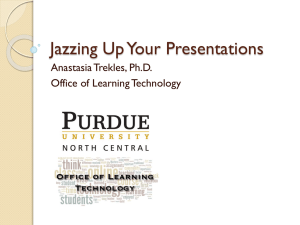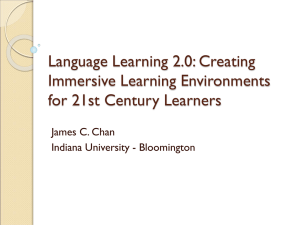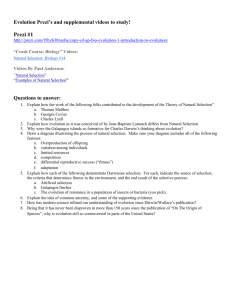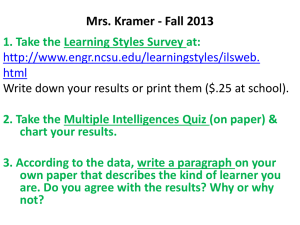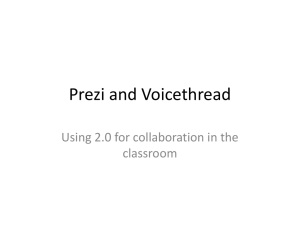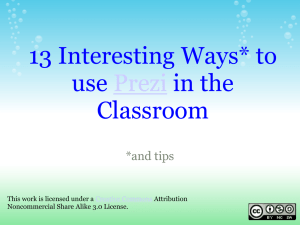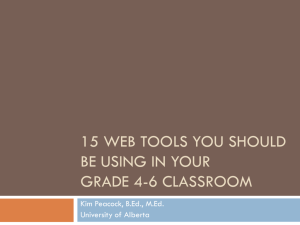Presentation File ()
advertisement
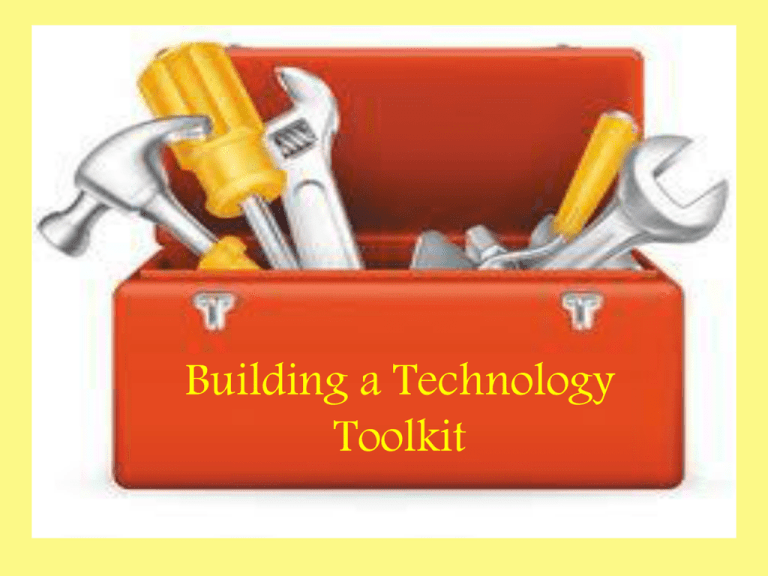
Building a Technology Toolkit Adding Technology to the Classroom • Learning Management Systems • Instructional delivery • Student projects Learning Management Systems “Instructor involvement guides appropriate use, both in terms of the nature of use and the extent of use […and] instructor involvement contributes to student benefits by affecting LMS information quality” (Klobas & McGill, 2010). Learning Management Systems Learning Management Systems Instructors can utilize an LMS in several ways, including • organization of course content • inclusion of interactive discussion forums • weekly announcements/reminders • electronic submission of assignments and assessments • innovative instructional delivery (i.e., links to YouTube, VoiceThread, or Prezi) • posting of individual and aggregate scores Instructional Delivery “With the explosion of tools, resources, and professional development for teachers, now is the perfect time to support deeper conceptual understanding of […] content by integrating technology in the classroom” (McCormack & Ross, 2010). Instructional Delivery Instructors can enhance delivery of course content with applications including • VoiceThread • Prezi • YouTube • Audio comments/memos • Dropbox VoiceThread VoiceThread is a free program that allows the creator to combine images, documents or videos with comments. Students can then listen to the commentary, which advances much like a PowerPoint. Prezi Prezi is a free, online alternative to PowerPoint. The advantages are a unique format, unlimited memory and easy access. YouTube With YouTube, you can provide students with links to welcome videos, video lectures, or video reminders. Audio Comments Audacity and AudioMemos (an iPad app) are just two of many audio recording applications that allow you to record a comment, a lecture or a reminder and convert it to an mp3 or wav file. These files can be sent to students via email or posted in an LMS, and students can access them multiple times. Dropbox Dropbox basically acts as an online flashdrive. You can load folders, files, photos, and videos into this free site, and you can access them with any of your devices (i.e., laptop, mobile phone, tablet). Student Projects “To ensure students are fully engaged in the learning process, educators must explore every available path for both formative and summative assessments. [Therefore], technology-based instruction must be given a place in schools and become a part of the mainstream curriculum” (Aronin & O’Neal, 2011). Student Projects Students can engage more deeply with classroom content via the use of digital technologies, including software, hardware and the Internet. Some great classroom additions include • MapSkip • ToonDoo • Video editing software • Survey creators • Shared document applications • Website builders MapSkip MapSkip allows students to understand the importance of place-based writing. It also provides students with an opportunity to consider how situations and locations can be connected to writing, geography, history, social sciences, and more. ToonDoo There are a variety of different uses for cartoons in the classroom, but this example shows its use as a graphic organizer for the final research project. Constructing dialogue also immerses students in the conversation surrounding their topic. Videos Students can use free programs, such as Animoto, or they can use video editing software (iMovie or Windows Movie Maker) to create visual essays, video trailers, PSAs, and more. Surveys Free online survey sites allow students to consider pertinent questions when researching, and it allows them to gather primary research. Analysis of the results of their surveys can help them ascertain purpose, audience, and thesis as well. Shared Documents Group projects are more easily planned and executed when using collaborative applications such as Google docs or wikis. Students can “share” with instructors; students can also work “together” at any time and from any place. Website Builders Students can use website builders to create electronic portfolios or to display a class project. Website construction hones organizational skills, encourages active participation, and fosters creativity and decision-making skills. Benefits of Building Your Own Toolkit A toolkit allows the owner to choose the appropriate tool at the appropriate time. Fundamentally, “[the] end goal should always be about student achievement and engagement; the technology is just one tool for reaching that goal” (Martineau, 2009).

